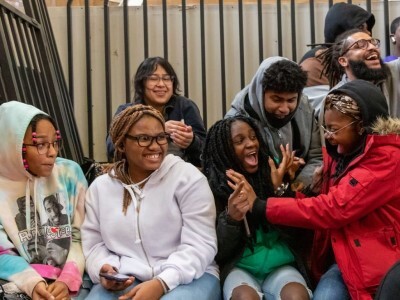Enabling Change
Changing the Education Narrative of CHANGE
Topics

Next generation learning is all about everyone in the system—from students through teachers to policymakers—taking charge of their own learning, development, and work. That doesn’t happen by forcing change through mandates and compliance. It happens by creating the environment and the equity of opportunity for everyone in the system to do their best possible work.
Today, more than ever, even the most traditional schools need to align our practices to develop the most productive citizens.
In a 2016 Gallup poll of 909,617 fifth through twelfth graders, from 3,000 schools in every state in the U.S. (except for Massachusetts), only 17 percent of 11th graders reported doing their best work in school. Additionally, only 32 percent of 11th graders reported being engaged with their school. That is frightening!
However, current research suggests giving students voice and choice in their learning, allowing them to solve real-world problems, and encouraging the completion of genius hour or passion projects can increase engagement and provide students with a deeper sense of purpose. (See articles in Reading Horizons, Edutopia, and EDUCAUSE Review for more on the research of student engagement.) Furthermore, employers are calling for future personnel to be equipped with skills like collaboration, creativity, critical thinking, and organization—all a far cry from content memorization. Finally, in an article for ASCD, Ryan Maxwell states, “Citizens are not born, but made through practice that fosters their lifelong contributions to a better world (2017).” He discusses the importance of getting students interested and involved in local politics by proposing research based solutions to community problems. They learn their voice and actions make a difference.
When we define what we deeply believe about learning, we establish practices that align with those core beliefs. When this process is collaborative, we create a shared sense of ownership in those beliefs.
Today, more than ever it is essential that even the most traditional schools begin discussing the need to align our practices to develop the most productive citizens. As a long-time Change Agent in my own school community, I can attest any change, even positive change, is hard. Change is painful and can be frightening, partly because it is messy and admitting there is a need for change requires us to vulnerably inspect our own practices. Our natural inclination is to seek solutions that have worked for others. But, looking for a quick fix to enact expedient change—answers to the HOW—may be detrimental to your organization in the long run. As more organizations begin to ask about and embrace “change” within the education system, we must challenge the current ways we think and talk about CHANGE.
The HOW
When faced with the prospect of change, teachers and administrators alike ask questions such as, “Why should I change, if what I am currently doing is working? How will I hold students accountable if they have the freedom to do what they want? How will I meet the needs of all of my students? How can I manage 30 different student projects at once? How do we get the entire staff on board? How will these changes affect the community’s perception of our school?” Often, the solution is to begin formulating a plan to answer our logistical “HOW” questions.
When faced with the prospect of change, parents ask, “How will you be preparing my student for college? How will you ensure my student is learning? How will you teach my child character without teaching them what to think? How do I know my student is prepared for their future?” To quell their anxiety, often we respond by measuring student knowledge through quizzes, tests, and standardized assessments, then report that data through report cards and score reports that arbitrarily define student success.
While I believe those invested in CHANGE have the best intentions, what if “HOW” is not the most effective place to start? In the 2001 book, The Answer to How is Yes: Acting on What Matters, Peter Block suggests, in our quest for expedient change we search for the answers to HOW. By starting with the HOW we are actually limiting creative potential solutions and the long-term sustainability of change by rushing past the WHY. So, we must first determine WHY. If the answer to WHY is important enough to our cause, we will persist to find our own solutions to the HOW. These solutions will meet the distinct needs of our unique schools and programs, and will result in long-term, sustainable change in our community.
Begin with the WHY
A worthy place to begin the conversation about CHANGE is to define why we must change. Perhaps consider first creating a collaborative definition of learning: What is learning and how will we measure it? Some sub-questions to guide this conversation could be: “What does learning look like and how is it most effectively measured? Is learning the short-term retention of basic content available on the internet? Is it the demonstration of understanding through an essay? A standardized test? How long should this learning last for our students? 15 minutes after the assessment? 6 weeks?” Consider using your PLCs or staff meetings to dig into the metacognitive understanding of learning. Challenge the current paradigms teachers hold about learning by performing deep inquiry together.
Will Richardson of Modern Learners recently interviewed Esme Capp, principal of Princes Hill Primary School outside of Melbourne, Australia. She began her school’s change process by having teachers explore what learning looked like in the context of modern learning theories, what teaching strategies would be used in conjunction with such theories, the depth of learning, and how that learning was assessed. From those collective inquiries, the staff developed five principles of learning that became a non-negotiable part of the school’s mission, vision, and culture.
Include Stakeholders
Establish the narrative about change within your local community by hosting discussions about the WHY with students and parents. These early conversations are necessary in fighting against those preconceived notions the local community holds about learning. These should occur early in the change process and often to challenge current beliefs about school and learning. Invite community members to participate on research teams so they better understand the need for change in our system. Encourage a parent group to determine what skills they want for their kids and solidify what this looks like in the classroom. Conduct student surveys about their beliefs about learning. Include students in conversations about what and how they are learning. These actions can lead to decreasing fears about and an increase in positive support for change.
The Journey toward CHANGE
In our journey toward change, why should we redirect the conversation from a focus on the HOW to consider the WHY? When we define what we deeply believe about learning, we establish practices that align with those core beliefs. When this process is collaborative, we create a shared sense of ownership in those beliefs. Every decision we make within our school and about our students must be guided by our shared, core beliefs. Only then, as Block suggests, we begin to seek creative solutions that align our practice with our beliefs.
Peter Senge (2006) says, “People don’t resist change. They resist being changed.” Staff must be inspired and influenced through an opportunity for deep discovery.9 They need space for difficult conversations. And most of all they need compassion and affirmation when sharing their fears. Parents need an understanding of what change means for their child’s future. Students must be committed to real learning, not playing school.
Progress requires change, therefore change is inevitable. The answer isn’t in seeking solutions to HOW we make change happen, but investing in the development of WHAT we believe and WHY change is important.




